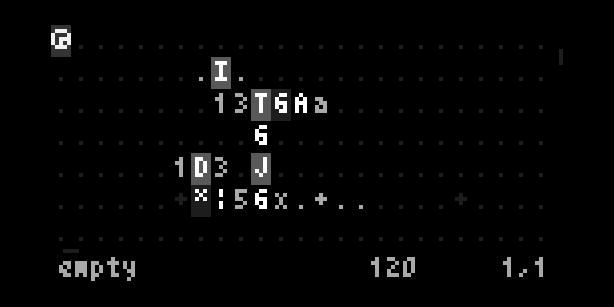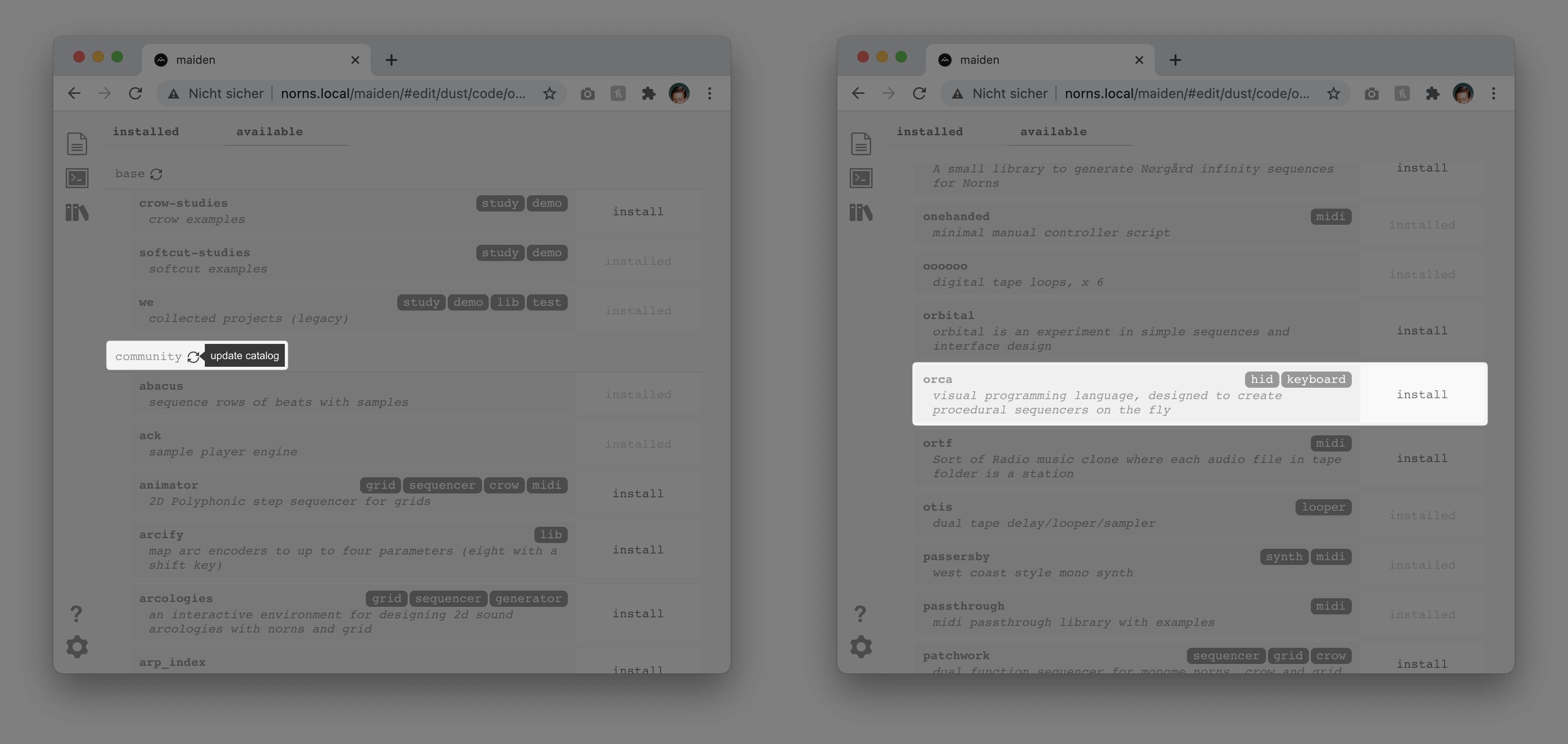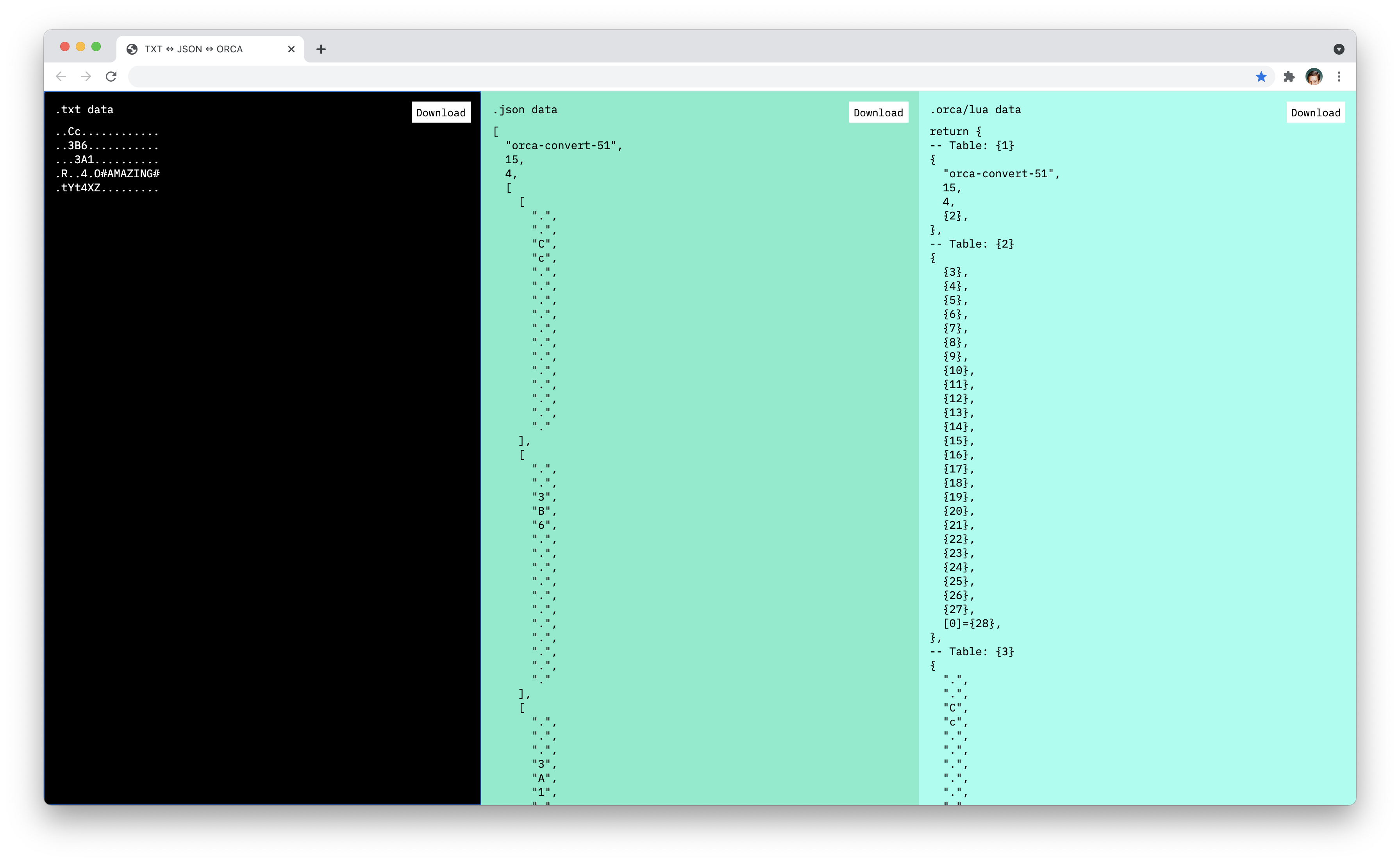Orca is a visual programming language, designed to create procedural sequencers on the fly.
............................
#.........█.................
#........█▒█......█.........
#.......█▒▒█.....█▒█........
#........██▒█....█▒█........
#.......██▒█▒█..█▒▒█........
#.......█▒▒██..█▒▒█.........
#........█▒██▒█▒▒█▒█........
#.........█▒▒▒▒████.........
#........█▒▒▒▒▒▒▒▒▒█........
#.......█▒▒▒▒█▒▒█▒▒▒█.......
#......█▒▒...▒▒▒▒..▒▒█......
#......█▒..█..▒▒..█..█......
#......█▒..█..▒▒..█..█......
#......█▒▒...▒██▒..▒▒█......
#.......█▒▒▒▒▒..▒▒▒▒█.......
#.........█▒▒▒▒▒▒▒▒█........
#........██▒..▒▒██..........
#.......██.█..▒██.██........
#..........█▒▒▒█............
#...........███.............
#.........░░█.█.............
#........░░░░▒█░............
#..........░░░░.............
............................
Orca for Norns supports 4 different engines, but in order for them to work they must be installed.
Orca for Norns is available for install within Maiden. Update the Community feed and then scroll down to Orca and Install.
If you're looking to contribute with code checkout the documentation for Contributing.
<tab>Info bar: Toggles info bar visibility<esc>Unfocus: Removes selection focus<space>Play/Stop: Toggles play state, stop kills all notes.cmd/ctrl + >Adjust BPM: Increments BPM + 10.cmd/ctrl + <Adjust BPM: Decrements BPM - 10.
Please refer to original docs for general Orca operation.
Aadd(a b): Outputs sum of inputs.Bsubtract(a b): Outputs difference of inputs.Cclock(rate mod): Outputs modulo of frame.Ddelay(rate mod): Bangs on modulo of frame.Eeast: Moves eastward, or bangs.Fif(a b): Bangs if inputs are equal.Ggenerator(x y len): Writes operands with offset.Hhalt: Halts southward operand.Iincrement(step mod): Increments southward operand.Jjumper(val): Outputs northward operand.Kkonkat(len): Reads multiple variables.Lless(a b): Outputs smallest of inputs.Mmultiply(a b): Outputs product of inputs.Nnorth: Moves Northward, or bangs.Oread(x y read): Reads operand with offset.Ppush(len key val): Writes eastward operand.Qquery(x y len): Reads operands with offset.Rrandom(min max): Outputs random value.Ssouth: Moves southward, or bangs.Ttrack(key len val): Reads eastward operand.Uuclid(step max): Bangs on Euclidean rhythm.Vvariable(write read): Reads and writes variable.Wwest: Moves westward, or bangs.Xwrite(x y val): Writes operand with offset.Yjymper(val): Outputs westward operand.Zlerp(rate target): Transitions operand to input.*bang: Bangs neighboring operands.#comment: Halts a line.
$r.note(scale-mode note): Outputs random note within scale.?levels(param value): Sets selected volume level on bang./softcut(playhead rec play level rate position).\softcut param(playhead param value): Sets softcut param on bang.|synth(octave note): Plays a note with the synth engine.-synth param(param value): Sets synth param on bang.:midi(channel octave note velocity length): Sends a MIDI note.%mono(channel octave note velocity length): Sends monophonic MIDI note.!cc(channel knob value): Sends MIDI control change.&midi in(channel): Outputs received midi note.^cc in(cc): Outputs received midi cc value.~crow cv(channel octave note attack release level):]crow ii jf note(channel octave note level): Just Friends over i2c in voice mode.}crow ii jf voice(octave note level): Just Friends over i2c in note mode.`crow w/syn(octave note level):>g.write(x y value): Sets Grid LED on bang.<g.read(x y): Reads specific coordinates. If value > 6 outputs bang.(a.read(enc): Reads Arc encoder value=OSC (path;x;y..): Locks each consecutive eastwardly ports.;is delimeter for values.
| Controller | Description | Values |
|---|---|---|
<tab> |
Info bar | Toggles info bar visibility |
<esc> |
Unfocus | Removes selection focus |
<space> |
Play/Stop | Toggles play state, stop kills all notes. |
cmd/ctrl + > |
Adjust BPM | Increments BPM + 10. |
cmd/ctrl + < |
Adjust BPM | Decrements BPM - 10. |
| Controller | Description | Values |
|---|---|---|
K1 + E1 |
Select operator | A–Z, $, ?, /, \, ` |
K1 + E2 |
Select value | 0–z |
K1 + E3 |
Select note | A–G |
K2 |
Clear character | |
K2 |
Toggle play/stop |
The R.NOTE operator $ takes 2 inputs(scale-mode, note).
This operator generates a scale based on the given mode (default is Dorian) and note/key (default is C). For example to generate an F natural minor scale enter $2F. There are 35 different modes to choose from:
1: Major2: Natural Minor3: Harmonic Minor4: Melodic Minor5: Dorian6: Phrygian7: Lydian8: Mixolydian9: Locriana: Gypsy Minorb: Whole Tonec: Major Pentatonicd: Minor Pentatonice: Major Bebopf: Altered Scaleg: Dorian Beboph: Mixolydian Bebopi: Blues Scalej: Diminished Whole Halfk: Diminished Half Wholel: Neapolitan Majorm: Hungarian Majorn: Harmonic Majoro: Hungarian Minorp: Lydian Minorq: Neapolitan Minorr: Major Locrians: Leading Whole Tonet: Six Tone Symmetricalu: Arabianv: Balinesew: Byzantinex: Hungarian Gypsyy: Persianz: East Indian Purvi
The LEVELS operator ? takes 2 inputs(param, value).
There are 9 different params that can be modulated on the fly with this operator:
1: level output channels2: level engine master3: level softcut master4: level ADC input5: reverb engine level6: softcut reverb level7: reverb DAC level8: softcut ADC level9: softcut engine level
In order to trigger parameter setting a bang * has to occure on the left side of operator. The value is simply the percentage to set the level 0 is 0% z is 100%. For example ?5z will set the engine reverb to 100%, or ?2h will set the engine volume level to 50%.
The SOFTCUT operator / takes up to 6 inputs (playhead rec play level rate position).
This operator receives a MIDI note from a MIDI controller, based on the channel value (default is channel 1).
playhead- values:
0-6: target playhead number
- values:
rec- values:
0: disables recording/overdub;1–z: recording level and amount of overdub preserve
- values:
play- values:
0: disables play;1: enables play
- values:
level- values:
0: 0,z: 35
- values:
rate- values:
0: 2x speed (reverse),i: normal (default),z: 2x speed (forwards)
- values:
position- values:
0: beginning of buffer,z: length of buffer.
- values:
A subset of Softcut's params are availabe with the SOFTCUT PARAMS operator \ (playhead param value). These 3 params are always required (along with a bang) to modulate a given parameter.
-
playhead- values:
0-6: target playhead number
- values:
-
1: Source- values:
0: 0 ADC level, 0 Softcut engine level;1: 1 ADC level, 0 Softcut engine level;2: 0 ADC level, 1 Softcut engine level;3: 1 ADC level, 1 Softcut engine level;
- values:
-
2: Pan- values:
0: full left,1: centered,2: full right
- values:
-
3: Rate slew time- values:
0: 0s,z: 35s
- values:
-
4: Level slew time- values:
0: 0s,z: 35s
- values:
The SYNTH operator | inputs vary based on selected engine, but (octave, note ...) are always required (along with a bang) to produce sound.
There are 4 different engine supported by Orca FM7, Passersby, PolyPerc, and Timber. Within the params menu engines can be changed. Note: when changing engines you will have to reengage the clock by pressing K3.
A "Polyphonic Synthesizer for Norns With 6 Operator Frequency Modulation". When this engine is selected, the SYNTH operator | takes up to 4 different inputs (octave, note, voice, amp). For example |4C.. will play a C at the 4th octave (Midi scale).
octave- values:
0-7
- values:
note- values:
A–G
- values:
voice- values:
0: 0s,z: 1.5s
- values:
amp- values:
0: 0.0,z: 1.0
- values:
A "West Coast style mono synth". When this engine is selected, the SYNTH operator | takes up to 6 different inputs (octave, note, velocity, timbre, pitchBend, pressure). For example |4Cz... will play a C at the 4th octave (Midi scale) with a velocity of 255.
octave- values:
0-7
- values:
note- values:
A–G
- values:
velocity- values:
0: 0,z: 125
- values:
timbre- values:
0: 0.0,z: 1.0
- values:
pitchBend- values:
0: 0.0,z: 1.0
- values:
pressure- values:
0: 1.5,z: 3.0
- values:
A "simple polyphonic filtered decaying square wave". When this engine is selected, the SYNTH operaptor | takes up to 2 inputs (octave, note). For example |4C will play a C at the 4th octave (Midi scale).
octave- values:
0-7
- values:
note- values:
A–G
- values:
A sample player engine and two scripts for norns. When this engine is selected, the SYNTH operator | takes up to 5 inputs (octave note sample level position). For example |4C1 will play the first sample and tune it a C at the 4th octave (Midi scale).
octave- values:
0-7
- values:
note- values:
A–G
- values:
sample- values:
0: 1,z: 36
- values:
level- values:
0: -48db,z: 16db
- values:
position- values:
0: start of samplez: end of sample
- values:
Note, in order for the position param to affect a clip, Timber only supports audio samples that are maximum: 10 seconds mono and 5 seconds stereo, as stated in the Timber source code. Longer clips (maximum 2 hours @ 44100 sample rate) can be played back, but position will have no effect.
Additional details
However, By reducing the sample rate you can use longer clips with the `position` param, because there's a direct relationship between mono/stereo, sample rate, and length of audio.Stereo
- Max 5 seconds stereo @ 44100 sample rate
- Max 10 seconds stereo @ 22050 sample rate
- Max 20 seconds stereo @ 11025 sample rate
- and so on...
Mono
- Max 10 seconds mono @ 44100 sample rate
- Max 20 seconds mono @ 22050 sample rate
- Max 40 seconds mono @ 11025 sample rate
- and so on...
Each synth engine has numerous settings to modulate its sound profile. The SYNTH PARAM operator - are (param value) (except for FM7 see below) these 2 params are always required (along with a bang) to modulate a given parameter.
When this engine is selected the SYNTH PARAM operator - takes up to 3 inputs (param value voice). This particular engine allows for a complex combination of params. For example -5i1 sets the "Osc(illator) Amp(litude) Env(elope) Attack" to 5.14 seconds for voice 1. Load the included to fm7-demo.orca demo to see more params (be sure to select FM7 within the params menu first).
1: Osc Frequency Multiplier (Hz)2: Osc Phase (radians)3: Osc Amplitude (decibels)4: Carrier Amplitude (decibels)5: Osc Amp Env Attack (seconds)6: Osc Amp Env Decay (seconds)7: Osc Amp Env Sustain (decibels)8: Osc Amp Env Release (seconds)9: Osc1 Phase Mod Osc (decibels)a: Osc2 Phase Mod Osc (decibels)b: Osc3 Phase Mod Osc (decibels)c: Osc4 Phase Mod Osc (decibels)d: Osc5 Phase Mod Osc (decibels)e: Osc6 Phase Mod Osc (decibels)
When this engine is selected the SYNTH PARAM operator - takes up to 2 inputs (param value). For example -51 sets the "Envelope Type " to "LPG". Load the included to passersby-demo.orca demo to see more params (be sure to select Passersby within the params menu first).
1: Amp2: Attack (seconds)3: Decay (seconds)4: Drift5: Envelope Type- values:
1: LPG,2: Sustain
- values:
6: FM Low Amount7: FM Low Ratio8: FM High Amount9: FM High Ratioa: Glide (seconds)b: LFO Frequency (Hz)c: LFO Shape- values:
1: Triangle,2: Ramp,3: Square,4: Random
- values:
d: LFO > Attacke: LFO > Decayf: LFO > FM Lowg: LFO > FM Highh: LFO > Frequency (Hz)i: LFO > Peakj: LFO > Reverb Mixk: LFO > Wave Foldsl: LFO > Wave Shapem: Peak (Hz)n: Pitch Bend Allo: Pressure Allp: Reverb Mixq: Timbre Allr: Wave Foldss: Wave Shape
When this engine is selected the SYNTH PARAM operator - takes up to 2 inputs (param value). For example -3z sets the "Release" to 3200ms. Load the included to polyperc-demo.orca demo to see more params (be sure to select PolyPerc within the params menu first).
1: Pulse width (%)2: Amp3: Release (seconds)4: Cutoff (Hz)5: Gain6: Pan- values:
0: left,i: center,z: right
- values:
When this engine is seleted the SYNTH PARAM operator - takes up to 3 inputs (param value sample). For example -811 sets the filter type to "high pass" for sample 1.
1: Amp env attack2: Amp env decay3: Amp env sustain4: Amp env release5: Detune cents6: Stretch [percentage]7: Filter freq8: Filter resonance9: Filter type- values:
0: Low Pass,1: High Pass
- values:
a: Quality- values:
0: Nasty,1: Low,2: Medium,3: High
- values:
b: Freq mod LFO 1c: Freq mod LFO 2d: Filter freq mod LFO 1e: Filter freq mod LFO 2f: Pan mod LFO 1g: Pan mod LFO 2h: Amp mod LFO 1i: Amp mod LFO 2j: Freq mod envelopek: Filter freq mod envelopel: Filter freq mod velocitym: Filter freq mod pressuren: Filter trackingo: Pan mod envelopep: Envelope attackq: Envelope decayr: Envelope sustains: Transposet: Stretch [length]u: Stretch [bars]- values:
0: 1/64,1: 1/48,2: 1/32,3: 1/24,4: 1/16,5: 1/12,6: 1/8,7: 1/6,8: 1/4,9: 1/3,a: 1/2,b: 2/3,c: 3/4,d: 1 bar
- values:
v: Pan- values:
0: left,i: center,z: right
- values:
w: Ampx: Envelope releasey: Start framez: End frame
The MIDI operator : takes up to 5 inputs (channel octave note velocity length).
The MONO operator % takes up to 5 inputs (channel octave note velocity length).
See Orca's Midi Mono documentation
The CC operator ! takes 3 inputs (channel knob value).
See Orca's Midi CC documentation
The MIDI IN operator & takes 1 input(channel).
This operator receives a MIDI note from a MIDI controller, based on the channel value (default is channel 1).
The CC IN operator ^ takes 1 input(channel).
This operator receives a MIDI CC message from a MIDI controller, based on the channel value (default is channel 1).
The CROW CV operator ~ takes up to 6 parameters (channel octave note attack release level).
channel- values:
0: crow out 1 is 1v/Oct CV and out 2 is an AR envelope;1: crow out 3 is 1v/Oct CV and out 2 is AR envelope.
- values:
octave- values:
0-7
- values:
note- values:
A–G
- values:
attack- values:
0: 0s,z: 1.5s
- values:
release- values:
0: 0s,z: 3s
- values:
level- values:
0: 0V,z: 10V
- values:
For example ~04Chhz sets channel to value 0, plays a C4 note with a 750ms attack, 750ms release, at 10V.
The CROW JF II NOTE operator ] takes up to 4 parameters (channel octave note level). For this operator, channel can be set 0-5 and sets which channel the voice is playing from.
The CROW JF II VOICE operator ] takes up to 3 parameters (octave note level).
The CROW JF W/SYN operator ` takes up to 3 parameters (octave note level).
The G.WRITE operator > takes up to 3 inputs (x y value) and activates Grid LED at given x, y coordinate.
The G.READ operator < takes up to 3 inputs (x y value) and read Grid at given x, y coordinate.
The A.READ operator ( takes 1 input(enc) and reads given Arc encoder value.
The OSC operator = takes up to 1 input(path;x;y..) locking each consecutive eastwardly ports. ; is delimeter for sending OSC values.
See Root Orca's OSC documentation
When Orca is installed, a number of tutorials (original) and demos are available to demonstrate basic and Norns specific functionalites.
This Norns port of Orca is capable of loading and exporting Orca .txt files. The creates interoperability for repositories such as Patchstorage.
Note change the file extension for files downloaded from Patchstorage to .txt. Upload the file to your Norns using SSH or FTP and use "> Load project" in the params menu to load a .txt file.
Conversely, you can also use this online coverter for either .txt files or even copying from other Orca's such as the web version or orca.wtf. This converter will import/export .txt, .json. or .orca (Norns) filetypes, which can then be uploaded to your Norns via SSH/FTP.
Cut and paste the following into the online coverter to see how it works.
..Cc............
..3B6...........
...3A1..........
.R..4.O#AMAZING#
.tYt4XZ.........
If you using MacOS, simply connect to your Norns via Finder's "Connect to Server". Alternatively, you can upload a file via sftp — such as an exported .orca file — to Norns (replace <filename> with name of your file).
$ sftp we@norns.local
$ put ./<filename>.orca /home/we/dust/data/orca/<filename>.orcaIf you're a developer interested in contributing features or fixes, checkout the contributing documentation.
There are 2 main branches used for maintaining quality of experience.


